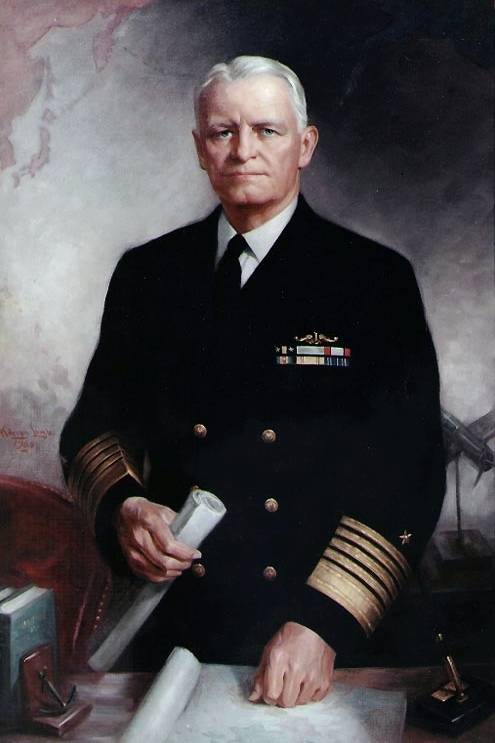
FAQ About Chester W. Nimitz

Who was Chester W. Nimitz?
Chester W. Nimitz was a Fleet Admiral of the United States Navy during World War II. He played a pivotal role in designing and implementing the strategy for the Naval campaigns in the Pacific during the war. Nimitz is best remembered for his leadership during key battles such as Midway and for his contribution to the Allied victory over Japan.

What were Chester W. Nimitz's contributions to World War II?
Admiral Chester W. Nimitz led the U.S. Pacific Fleet during World War II, contributing significantly to the Allied strategy and execution of naval operations against Japan. His most notable contribution was his strategic planning and leadership during the Battle of Midway, which is considered a turning point in the Pacific Theater. He was instrumental in organizing the island-hopping campaign that eventually led to the defeat of Japan.

How did Chester W. Nimitz become a Fleet Admiral?
Chester W. Nimitz was promoted to Fleet Admiral shortly after World War II, a rank created for him among others to recognize their extraordinary service. His promotion to this five-star rank was due to his successful leadership and strategic planning that proved crucial to the Allied victory in the Pacific Theater.

What was the significance of the Battle of Midway under Nimitz's command?
The Battle of Midway, commanded by Admiral Nimitz, was a turning point in World War II in the Pacific. It took place in June 1942, where the U.S. Navy inflicted a significant defeat on the Japanese Imperial Fleet, sinking four of its aircraft carriers. Nimitz's leadership and decisions during this battle materially shifted the balance of power in the Pacific towards the Allies.

What strategy did Chester W. Nimitz employ in the Pacific theater?
Chester W. Nimitz employed a strategy known as "island hopping" in the Pacific Theater. This involved bypassing heavily fortified Japanese positions and capturing strategically important islands to gradually push Japanese forces back towards the home islands. This approach minimized Allied casualties and depleted Japanese resources leading to their eventual surrender.

Was Chester W. Nimitz involved in any post-war activities?
After World War II, Chester W. Nimitz served in various capacities, including as a member of the United Nations Military Staff Committee. His contribution in the post-war era focused on peace and rebuilding efforts, harnessing his leadership experience to support global security initiatives.

What awards and honors did Chester W. Nimitz receive?
Fleet Admiral Chester W. Nimitz received numerous awards and honors throughout his career. Among the most notable are the Navy Distinguished Service Medal with four Gold Stars, the Silver Star, the Legion of Merit, and the Army Distinguished Service Medal. He is widely celebrated for his military acumen and strategic brilliance.

How did Chester W. Nimitz's early career prepare him for later success?
Nimitz's early career featured diverse assignments, including submarine service and naval education roles. He developed technical expertise and leadership skills that later distinguished his command excellence. His ability to adapt and innovate was pivotal during the intense challenges of World War II.

Did Chester W. Nimitz have any notable personal characteristics?
Chester W. Nimitz was known for his calm demeanor, strategic foresight, and effective communication skills. His ability to remain composed under pressure was critical during his wartime service, earning him respect among contemporaries and subordinates.

What educational background did Chester W. Nimitz have?
Chester W. Nimitz attended the United States Naval Academy at Annapolis, graduating in 1905. His education at the academy provided him with lifelong skills in naval strategy and leadership, which he continuously refined throughout his military career.

When and where was Chester W. Nimitz born?
Chester W. Nimitz was born on February 24, 1885, in Fredericksburg, Texas, USA. His Texan roots were a foundation for his strong character and leadership qualities that would emerge throughout his naval career.

What role did Chester W. Nimitz play after the Battle of Midway?
After the Battle of Midway, Chester W. Nimitz continued his leadership of the Pacific Fleet, implementing the island-hopping strategy and preparing for major operations such as the Gilbert and Marshall Islands campaign. His strategic insights during these operations continued to contribute to the U.S. Navy's success in the Pacific.

Did Chester W. Nimitz write any books or memoirs?
Chester W. Nimitz collaborated with E.B. Potter on the book "Sea Power: A Naval History," though he did not write a personal memoir. His insights into naval strategy and leadership are captured in various historical accounts and biographies written by others.

How did Chester W. Nimitz's leadership style impact his team?
Nimitz’s leadership style focused on clear communication, delegation, and trust in his team's capabilities. This approach fostered respect and collaboration among his subordinates, making them more efficient and effective in executing complex naval operations.

What was the significance of Chester W. Nimitz's promotion to Fleet Admiral?
Nimitz's promotion to Fleet Admiral marked a significant recognition of his leadership and strategic contributions during World War II. It was a symbol of his status as one of the top military leaders of his time, cementing his legacy in naval history.

Where is Chester W. Nimitz buried?
Chester W. Nimitz is buried at Golden Gate National Cemetery in San Bruno, California. He rests alongside other notable military figures, honoring his legacy as one of America's revered naval leaders.

What role did Chester W. Nimitz play in the Pacific Fleet's victory over Japan?
As Commander-in-Chief, U.S. Pacific Fleet and Pacific Ocean Areas, Nimitz directed operations that led to the Allied victory over Japan. His strategic foresight and leadership contributed significantly to the successful island campaigns and naval battles that culminated in Japan's surrender in 1945.
